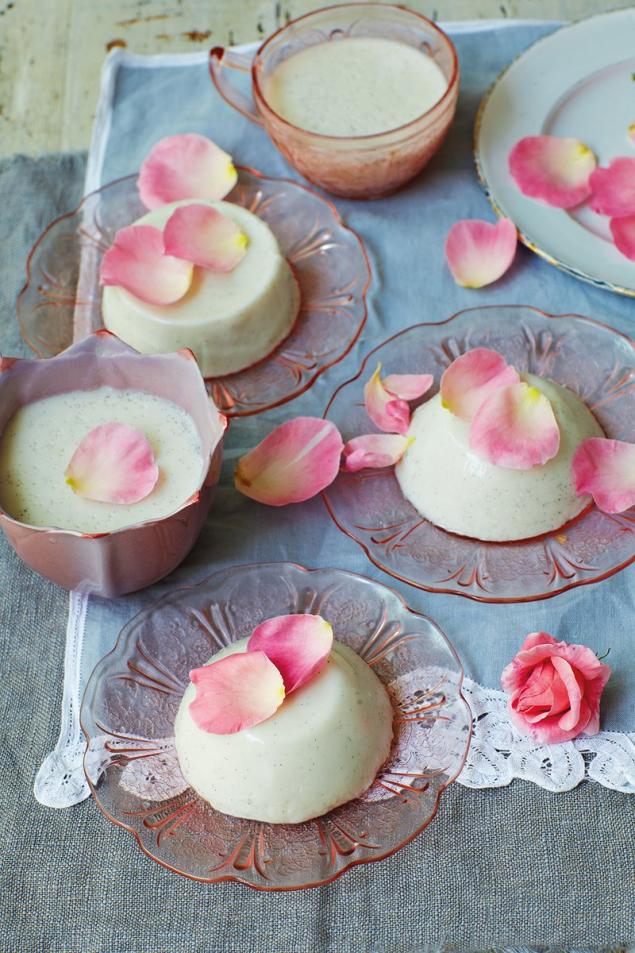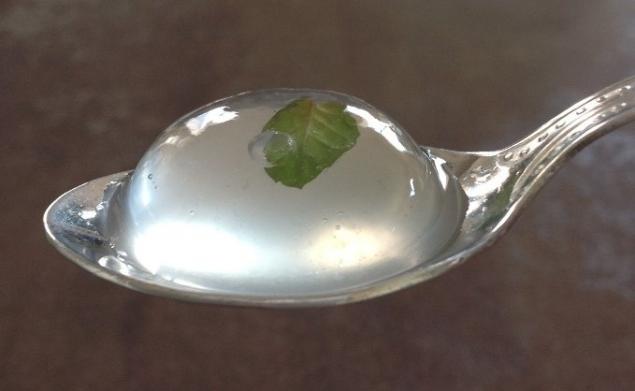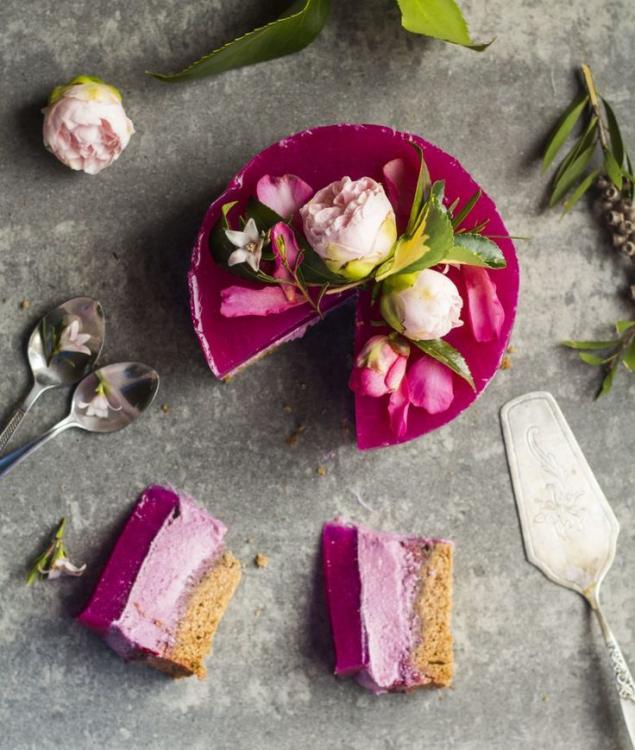468
Agar-agar is a useful alternative to gelatin: application rules
Agar-agar used to make jellies, marshmallows, bird, milk, jelly, soufflé, for meat and fish aspic dishes, for the manufacture of ice cream, sauces, marinades, and also for the clarification of beverages.
It should be noted that agar-agar is completely a natural product, additionally it is rich in iron and iodine, it also has antibacterial property that contributes to long-term storage of food.

Agar-agar is odorless and tasteless and is most often found in powder-flour, not soluble in cold water. Be dissolved in water at a temperature of from 90 to 100 degrees. Agar solidifies at 40 degrees and fully formed to the desired consistency chilled below 30 degrees.
1 teaspoon of agar-agar (gel strength 1200) replaces 8 teaspoons of gelatin.
Agar-agar gelatin is a great substitute and will require 3-4 times less than a conventional packaged gelatin. It is more powerful and gives more dense structure. It turns out that it is not necessary to overdo the dosage in recipes.
Estimated consumption of agar-agar: 2 to 4 grams (not the full 1 teaspoon) of 150-180 ml.

Before you can use agar-agar is to remember:
1. What liquid and what kind of acidity you use?
Than the acidity of the liquid is higher, the greater the agar-agar to add. This is due to the fact that the acid reduces gelling properties of substances, including agar-agar. For example, 100 ml of neutral liquid (water, broth, milk), use a 0.9 — 1 grams of agar-agar, and 100 ml of acidic liquid (juice) add to 1.3 — 1.5 grams of agar-agar.
2. What structure meals you wish to receive at the end of cooking?
Agar-agar is added to dishes, the consistency, texture and density, which can vary depending on the recipe or Your taste preferences. The following is the required amount of agar-agar to obtain the texture of the final product:

The technique of using Agar-agar agar-Agar diluted in different hot liquids, it can be water, broth, juice, milk.
Then the mass is thoroughly mixed and allow to infuse for 15 minutes.
Next, you need the liquid to a boil, while stirring constantly. Agar-agar must be completely dissolved.
After the boiling process, add in the mass of additives ( fruit, chocolate, spices, herbs) and allow it to cool at first at room temperature, and then in the fridge.
The prepared solution is a mass sufficiently viscous and transparent.
After complete cooling it becomes a solid gel, clean and termoobrabotki. This means that mass can be re-heated, it will turn into liquid, and upon further freezing, again formed in the gel.
Important! To check the correct dosage agar-agar to 1 teaspoon of the cooked mixture put in the freezer for 20-30 seconds. If the ground is frozen, it means the proportion is correct and is appropriate for the dish. If the mass is not grasped and is not frozen, add a little more agar-agar and pour into the bulk. Cook with love!
Author: Stilinsky VG
P. S. And remember, only by changing their consumption - together we change the world! ©
Source: deluxe.com.ua/articles/spetsii/agar-agar-culinary-use.html
It should be noted that agar-agar is completely a natural product, additionally it is rich in iron and iodine, it also has antibacterial property that contributes to long-term storage of food.

Agar-agar is odorless and tasteless and is most often found in powder-flour, not soluble in cold water. Be dissolved in water at a temperature of from 90 to 100 degrees. Agar solidifies at 40 degrees and fully formed to the desired consistency chilled below 30 degrees.
1 teaspoon of agar-agar (gel strength 1200) replaces 8 teaspoons of gelatin.
Agar-agar gelatin is a great substitute and will require 3-4 times less than a conventional packaged gelatin. It is more powerful and gives more dense structure. It turns out that it is not necessary to overdo the dosage in recipes.
Estimated consumption of agar-agar: 2 to 4 grams (not the full 1 teaspoon) of 150-180 ml.

Before you can use agar-agar is to remember:
1. What liquid and what kind of acidity you use?
Than the acidity of the liquid is higher, the greater the agar-agar to add. This is due to the fact that the acid reduces gelling properties of substances, including agar-agar. For example, 100 ml of neutral liquid (water, broth, milk), use a 0.9 — 1 grams of agar-agar, and 100 ml of acidic liquid (juice) add to 1.3 — 1.5 grams of agar-agar.
2. What structure meals you wish to receive at the end of cooking?
Agar-agar is added to dishes, the consistency, texture and density, which can vary depending on the recipe or Your taste preferences. The following is the required amount of agar-agar to obtain the texture of the final product:
- liquid texture – 0.8 g/500 ml (0.16 percent)
- soft texture – 1.5 g/500 ml (0.3%)
- dense texture – 5 g/500 ml (1 %)
- very dense texture – 7 g/500ml (1,4%)
- confectionery – 10-20 g per 1 kg of product
- glaze, coating: 10-30 g per 1 kg of product
- ice cream, mayonnaise, sauces – 5-10 grams per 1 kg of product
- for the clarification of beverages, juices – 0,5-1,5 g on 1 kg of liquid

The technique of using Agar-agar agar-Agar diluted in different hot liquids, it can be water, broth, juice, milk.
Then the mass is thoroughly mixed and allow to infuse for 15 minutes.
Next, you need the liquid to a boil, while stirring constantly. Agar-agar must be completely dissolved.
After the boiling process, add in the mass of additives ( fruit, chocolate, spices, herbs) and allow it to cool at first at room temperature, and then in the fridge.
The prepared solution is a mass sufficiently viscous and transparent.
After complete cooling it becomes a solid gel, clean and termoobrabotki. This means that mass can be re-heated, it will turn into liquid, and upon further freezing, again formed in the gel.
Important! To check the correct dosage agar-agar to 1 teaspoon of the cooked mixture put in the freezer for 20-30 seconds. If the ground is frozen, it means the proportion is correct and is appropriate for the dish. If the mass is not grasped and is not frozen, add a little more agar-agar and pour into the bulk. Cook with love!
Author: Stilinsky VG
P. S. And remember, only by changing their consumption - together we change the world! ©
Source: deluxe.com.ua/articles/spetsii/agar-agar-culinary-use.html
Mercedes-Benz accelerates the development of electric vehicles
Julia simultaneously about "Should" and "do Not want"























